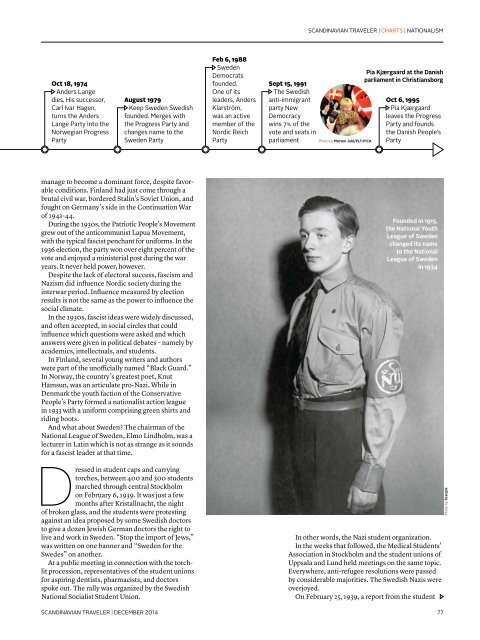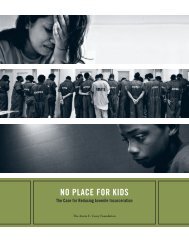st1412_webb
st1412_webb
st1412_webb
Create successful ePaper yourself
Turn your PDF publications into a flip-book with our unique Google optimized e-Paper software.
SCANDINAVIAN TRAVELER | CHARTS | NATIONALISM<br />
Oct 18, 1974<br />
Anders Lange<br />
dies. His successor,<br />
Carl Ivar Hagen,<br />
turns the Anders<br />
Lange Party into the<br />
Norwegian Progress<br />
Party<br />
August 1979<br />
Keep Sweden Swedish<br />
founded. Merges with<br />
the Progress Party and<br />
changes name to the<br />
Sweden Party<br />
Feb 6, 1988<br />
Sweden<br />
Democrats<br />
founded.<br />
One of its<br />
leaders, Anders<br />
Klarström,<br />
was an active<br />
member of the<br />
Nordic Reich<br />
Party<br />
Sept 15, 1991<br />
The Swedish<br />
anti- immigrant<br />
party New<br />
Demo cracy<br />
wins 7% of the<br />
vote and seats in<br />
parliament<br />
Photo by Morten Juhl/FLT-PICA<br />
Pia Kjærgaard at the Danish<br />
parliament in Christiansborg<br />
Oct 6, 1995<br />
Pia Kjærgaard<br />
leaves the Progress<br />
Party and founds<br />
the Danish People’s<br />
Party<br />
manage to become a dominant force, despite favorable<br />
conditions. Finland had just come through a<br />
brutal civil war, bordered Stalin’s Soviet Union, and<br />
fought on Germany’s side in the Continuation War<br />
of 1941-44.<br />
During the 1930s, the Patriotic People’s Movement<br />
grew out of the anticommunist Lapua Movement,<br />
with the typical fascist penchant for uniforms. In the<br />
1936 election, the party won over eight percent of the<br />
vote and enjoyed a ministerial post during the war<br />
years. It never held power, however.<br />
Despite the lack of electoral success, fascism and<br />
Nazism did influence Nordic society during the<br />
interwar period. Influence measured by election<br />
results is not the same as the power to influence the<br />
social climate.<br />
In the 1930s, fascist ideas were widely discussed,<br />
and often accepted, in social circles that could<br />
influence which questions were asked and which<br />
answers were given in political debates – namely by<br />
academics, intellectuals, and students.<br />
In Finland, several young writers and authors<br />
were part of the unofficially named “Black Guard.”<br />
In Norway, the country’s greatest poet, Knut<br />
Hamsun, was an articulate pro-Nazi. While in<br />
Denmark the youth faction of the Conservative<br />
People’s Party formed a nationalist action league<br />
in 1933 with a uniform comprising green shirts and<br />
riding boots.<br />
And what about Sweden The chairman of the<br />
National League of Sweden, Elmo Lindholm, was a<br />
lecturer in Latin which is not as strange as it sounds<br />
for a fascist leader at that time.<br />
D<br />
ressed in student caps and carrying<br />
torches, between 400 and 500 students<br />
marched through central Stockholm<br />
on February 6, 1939. It was just a few<br />
months after Kristallnacht, the night<br />
of broken glass, and the students were protesting<br />
against an idea proposed by some Swedish doctors<br />
to give a dozen Jewish German doctors the right to<br />
live and work in Sweden. “Stop the import of Jews,”<br />
was written on one banner and “Sweden for the<br />
Swedes” on another.<br />
At a public meeting in connection with the torchlit<br />
procession, representatives of the student unions<br />
for aspiring dentists, pharmacists, and doctors<br />
spoke out. The rally was organized by the Swedish<br />
National Socialist Student Union.<br />
SCANDINAVIAN TRAVELER | DECEMBER 2014<br />
Founded in 1915,<br />
the National Youth<br />
League of Sweden<br />
changed its name<br />
to the National<br />
League of Sweden<br />
in 1934<br />
In other words, the Nazi student organization.<br />
In the weeks that followed, the Medical Students’<br />
Association in Stockholm and the student unions of<br />
Uppsala and Lund held meetings on the same topic.<br />
Everywhere, anti-refugee resolutions were passed<br />
by considerable majorities. The Swedish Nazis were<br />
overjoyed.<br />
On February 25, 1939, a report from the student<br />
77<br />
Photo by Scanpix



